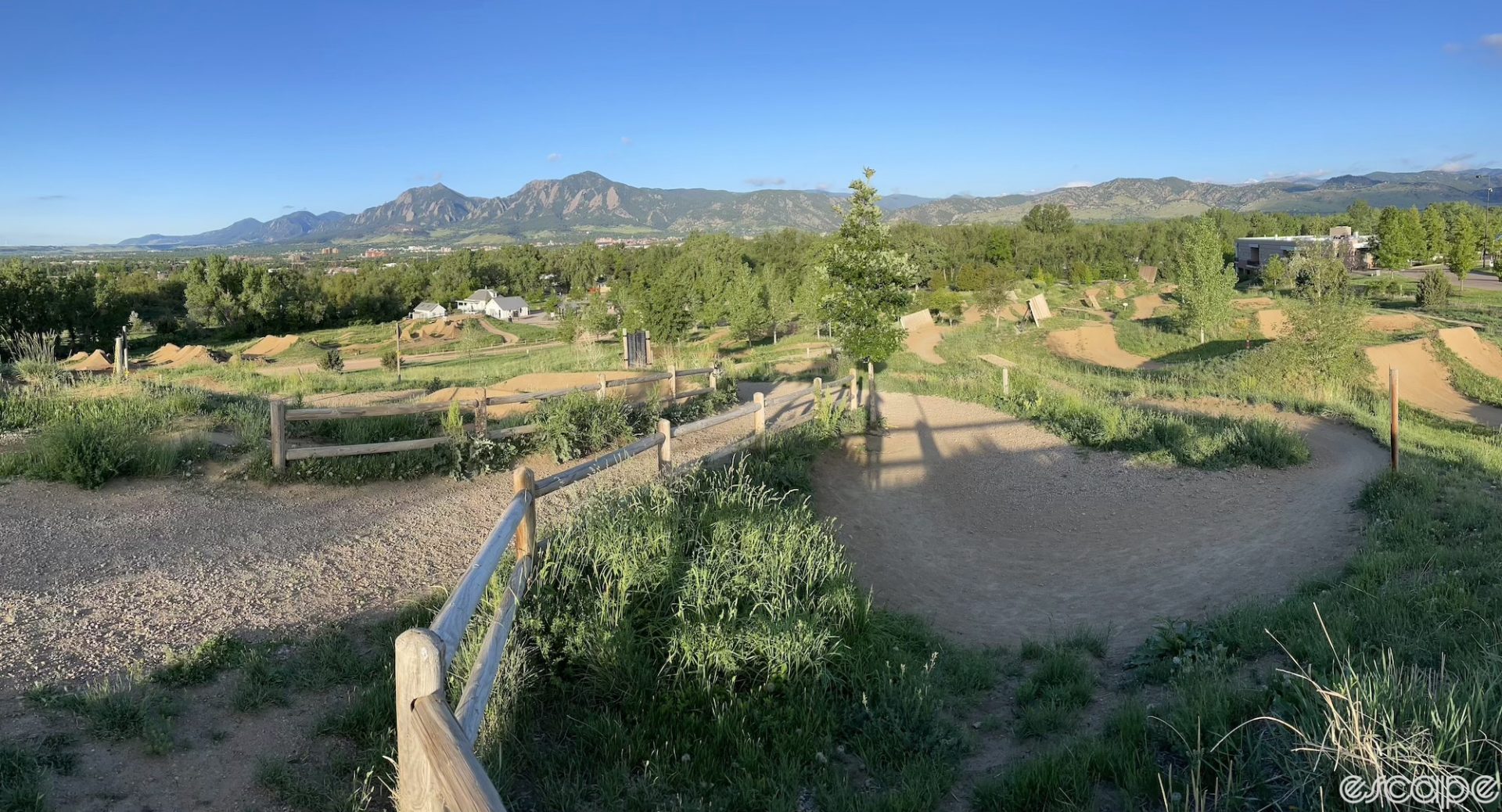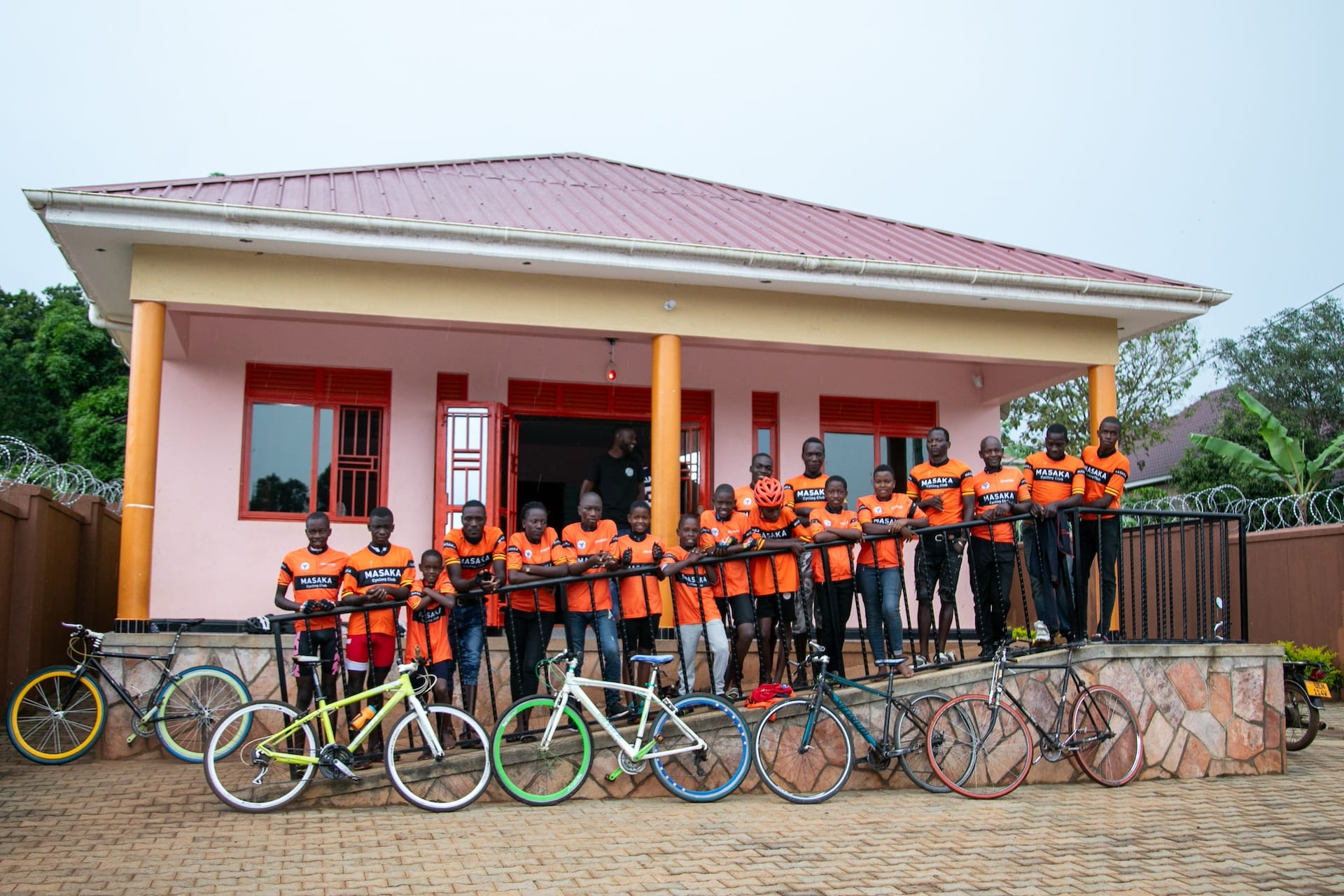Note: This ran in our member newsletter last week. But since non-members don't get that newsletter, we wanted to run it here too.
For five summers now, I get up early one morning a week to head to Valmont Bike Park, my local, and practice hucking my meat. I do this in the early morning for various reasons, but one of them is so that no one sees me. You see, as I am – no joke – the World’s Worst Dirt Jumper, I have in five years of practice progressed to riding part of the medium slopestyle line. But only part of it, because there’s a step-down about halfway down the line that I still can NOT find the courage to hit. You’d laugh; it’s tiny. But to a middle-aged reformed roadie with an acute sense of his own mortality and now a reminder of the same in the form of a cochlear implant (hitting your head=bad), it’s a cliff.
A little over a year ago, Wade and Caley sent out the first message about what would become Escape Collective, a message asking for your support. Now, 13-odd months, 15 employees (plus contributors), and some 1,600 stories and podcasts later, we’re an actual media outlet, and one built on something other than the dominant, century-old business model of media businesses: advertising.
What we’re doing isn’t entirely new. But it is new enough that there’s no sure blueprint for success. We’re taking some old ideas from the pre-digital era – namely that cultivating a small, passionate audience can be a more durable and sustainable foundation than chasing a large, indifferent, and transient one – and grafting those onto modern media realities.
In the pre- and early-digital eras, you could do decently well as a 100,000-circulation print magazine in a niche subject matter. There were many (I used to work at one, called Bicycle Guide). Most are gone now, and of the ones that remain, it’s not lost on me that the most durable are titles like Surfer’s Journal (est. 1992), Alpinist (2002), Adventure Journal (2008), or cycling’s own Mountain Flyer (2004). None have huge reach in terms of raw circulation and each has its own significant challenges, but they’ve all (so far) survived where others did not. And while all take modest amounts of advertising, what really aligns them is that they are largely reader-supported.
Some of what characterizes those magazines – a clean, uncluttered design that lets quality editorial and photography shine – inspires our approach here at Escape. But as a digital publication, we can’t survive on publishing 10-15 longform features a quarter. Those stories are fantastic, but trust me as someone who’s written them, they are massive amounts of work, and function best when delivered all together on a bi-monthly or quarterly cadence, printed on large format, perfect-bound, 80-lb paper stock. It might not escape your notice that none of those publications has a big online presence; small staffs can do one or the other, but not both. If we published one story a week, no matter how good it is, not enough people would pay to make that viable.

We also understand that, modern media consumption being what it is, many people visit our site on mobile, or not at all; some of you just listen to our podcasts, or read our e-mail newsletters, or hang out on our Discord (a refreshingly positive and fun slice of social media, we might add). We have to create more – and more varied – editorial content, to keep audiences coming back. But as sure as there’s a lower limit to what frequency works best, there’s an upper one too. In the old ad-driven business model, traffic is king, and volume is the way to deliver it. But that’s not what we’re doing.
We can’t, and shouldn’t, publish 100 stories a week because to get that kind of volume, we tip from substantive, quality work to “Mathieu van der Poel farted today” and “The 10 best road cycling shoes for coffee breaks.” That’s the kind of frequency the ad and commerce content models require, even as the collision of deflating ad rates and declining audiences (partly driven away by eroding editorial quality and a user experience that seems designed to trigger a seizure) has helped speed an industry-wide death spiral.
So that’s where we’re in new territory. How many stories, of what kinds, do we need to publish a week or a month to make this work? What other kinds of editorial content – podcasts, newsletters, stuff we haven’t dreamed up yet – do we need? And crucially: how do we measure what’s working and what’s not?
At some point (not imminently), modest amounts of advertising will likely become part of our business. But even then, it will look different than what you see elsewhere. For marketers, we can’t deliver the millions of eyeballs they’ve become accustomed to buying (we can deliver something more valuable, however). So for us, measuring traffic has limited meaning and relevance, because it doesn't correlate to either product quality or revenue from pageviews. We don’t do commerce content, so affiliate revenue from sales conversions is like a foreign currency we can't exchange.
We’ve had to unlearn a lot of conventional wisdom about what metrics matter most in media, and create some of our own to understand what it is you like about Escape Collective, and what you want more (or less) of. After close to a year, we’re starting to get a handle on the broadest outlines of what that is, although there’s a lot we still don’t know and more that we think we know and are probably wrong about.
But many of our hunches have been borne out. We wouldn't be alive if they hadn't. Thousands of you have found enough value in what we do to give us your hard-earned money to support us, and we are forever humbled and grateful. Ultimately, that’s the metric that we come back to most often: is what we’re doing – the stories and the photo galleries and the podcasts and the newsletters – the kind of thing that spurs people to sign up as members, or to renew?
This March, we’re going to find out. Because we launched with annual membership options at first, there is a substantial number of you who come up for renewal in a few weeks’ time. We’ve done the surveys, we’ve run the numbers, and we’ve looked at the experiences of some of our peer publications. We’re reasonably confident that we’ve demonstrated to our members that what we do has high value. For non-members, those of you who have found us but have yet to make the decision to join, we’re hopeful that what we’ve shown you in the past year helps you answer the question, “Are we worth your support?” with a strong “Yes.”
It’s only mid-February as you read this, but the days are getting perceptibly longer, and the air warms a bit. Soon, it’ll be time for me to grab my battered yellow dirt jumper and head back to Valmont. Maybe this year, I’ll find the courage to hit that drop for the first time. Maybe I’ll land it with steez to spare and wonder why it had ever loomed so large in my mind. Maybe I’ll dead-sailor the takeoff a bit but manage to stick the landing. Maybe I’ll crash and scare the daylights out of myself.
But just like I’ll never know if I can land that step down until my back wheel hits the dirt, we won’t know for sure that what we have built here will really, truly sustain until we get past that renewal cliff. If we crash? The one thing I can promise you is – like dirt jumping – succeed or fail, every day we will get back up to do it again. Because if we keep working at it, and get it right enough, often enough, we can build something different, something meaningful and worthwhile that you love and find worthy of support, something lasting. Let’s go find a cliff to huck.
Did we do a good job with this story?




